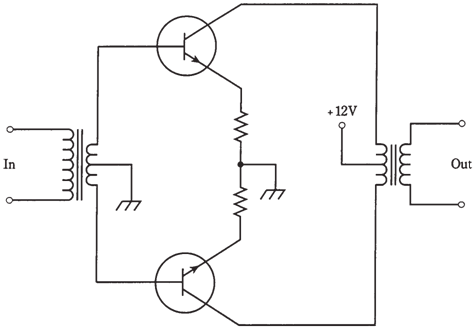The class-B amplifier
When the bipolar transistor is biased at cutoff exactly, or an FET at pinchoff, less than zero input signal conditions, the amplifier is working in class B. These operating points are labeled on curves in the Figures given below.
In class-B operation, there is no collector current or drain current when there is no signal. This saves energy, as the circuit is not eating up any power unless there is a signal going into it. When there is an input signal, current flows in device during exactly 1/2 of the cycle. The output waveshape is different from input waveshape in a class-B amplifier; actually it is half-wave rectified.
At times 2 bipolar transistors or FETs are used in class-B circuit, one for the positive 1/2 of the cycle and the other for the negative 1/2. In this manner, distortion can be eliminated. This is called as class-B push-pull amplifier. A class-B push-pull circuit by using 2 NPN bipolar transistors is illustrated in the Figure given below. This configuration is popular for the audio-frequency power amplification. It combines efficiency of class B with low distortion of class A. Its basic disadvantage is that it needs 2 center-tapped transformers, one at input and other at the output. This translates into 2 things which the engineers do not like: bulk and high cost.
The class-B scheme lends itself to the radio-frequency power amplification. Although output waveshape is distorted, resulting in the harmonic energy, this problem is overcome by a resonant LC circuit in the output. If signal is modulated, the modulation waveform will not be distorted.
You will sometimes hear of class-AB or class-B linear amplifiers, particularly in ham radio. The term linear refers to fact that modulation waveform is not distorted by the amplifier. The carrier wave is, as you have seen, affected in the nonlinear fashion, as the amplifiers are not biased in straight-line part of operating curve.

Figure-- A class-B push-pull amplifier.
The class-AB2 and class-B amplifiers take some power from input signal source. Engineers say that this type amplifier requires a certain amount of drive or driving power to function. The class A and class AB1 amplifiers theoretically require no driving power, although there should be an input voltage.